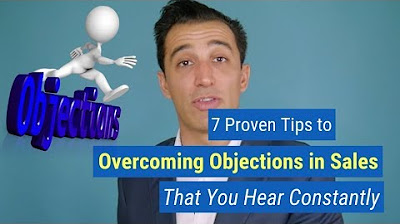The 5-Step Process to Overcome Any SMMA Objection
Summary
TLDRThis video script offers a comprehensive guide for overcoming sales objections, a common challenge for beginners. It emphasizes the importance of preparation and prevention techniques to make closing deals effortless. The script outlines a five-step process to tackle objections effectively, starting with diffusing the objection and reframing the conversation towards the customer's goals. It also highlights the significance of trust in sales, using the analogy of a life-saving medication to illustrate the point that objections often stem from a lack of trust rather than the stated reasons. The video aims to equip viewers with strategies to prevent and handle objections, leading to smoother sales calls and increased client acquisition.
Takeaways
- 😀 Sales objections are a common challenge for beginners and can be frustrating, but they can be overcome with preparation and strategy.
- 🔑 It's crucial to prepare for objections in advance and understand how to prevent them to make closing deals as effortless as possible.
- 👍 A great salesperson not only handles objections but also prevents them from arising by addressing concerns before they become objections.
- 🤔 Before discussing pricing, ensure all the prospect's questions are answered and gauge their interest level with a 1 to 10 tie-down.
- 📝 Asking a prospect where they stand on a scale from 1 to 10 helps identify any doubts and allows for addressing them before moving forward.
- 💡 The goal is to have the prospect feel sold on the offer before discussing pricing, to avoid handling objections and instead have them ready to purchase.
- 🌟 Most objections are trust-based but are disguised as something else; understanding this can help in overcoming them effectively.
- 💰 Objections often involve 'smoke screens' like needing to speak to a spouse or considering finances, which are really about a lack of trust.
- 📈 Objections typically fall into five categories: think about it, business partner or spouse, finances, doubt, and logistics.
- 🛑 The five-step process to overcome objections includes diffusing the objection, reframing the perspective, tie-down for agreement, isolating the real objection, and overcoming it with analogies and logic.
- 📚 Creating an 'Objection Playbook' can help in preparing responses and strategies for common objections, tailored to the salesperson's style.
Q & A
What is the main challenge faced by beginners in sales calls?
-The main challenge faced by beginners in sales calls is dealing with objections, especially when they arise unexpectedly after discussing the price.
Why is it important to prepare for objections in advance?
-Preparing for objections in advance is important because it helps to understand the best strategies to overcome them, which can lead to closing deals more effortlessly.
What is the goal of using prevention objection techniques?
-The goal of using prevention objection techniques is to make closing deals as effortless as possible by addressing and preventing objections before they arise.
What are the two things a salesperson should do before discussing pricing with a prospect?
-Before discussing pricing, a salesperson should ensure that the prospect has all their questions answered and perform a 1 to 10 tie-down to gauge the prospect's level of interest and identify any doubts they might have.
How does a 1 to 10 tie-down serve a dual purpose in a sales call?
-A 1 to 10 tie-down serves a dual purpose by gauging the prospect's level of interest and providing a clear indication of any doubts they might have, allowing the salesperson to address these concerns.
What is the significance of the 'fight or flight' state in the context of sales objections?
-The 'fight or flight' state signifies a defensive or evasive response from the prospect when faced with a perceived push to buy. It's crucial for salespeople to avoid triggering this state to maintain a productive conversation.
What is the first step in overcoming any sales objection according to the script?
-The first step in overcoming any sales objection is to diffuse the objection by showing understanding and avoiding confrontation, making the prospect feel that their concerns are valid.
Why is reframing important after diffusing an objection?
-Reframing is important to shift the prospect's focus away from the objection and towards the end goal, reminding them of the reasons they considered the service in the first place.
What is the purpose of a tie-down in the sales process?
-A tie-down serves to get a micro-commitment or agreement from the prospect throughout the sales process, indicating that they are following along and agreeing with the salesperson's points.
How can understanding the five categories of objections help a salesperson?
-Understanding the five categories of objections helps a salesperson to have frameworks in place to handle objections effectively, making their job easier and increasing the chances of closing a deal.
What is the final step in the five-step process to overcome objections?
-The final step is overcoming the objection by using analogies, logic, and reframes that suit the prospect, demonstrating confidence and authority while having a service-over-sales mentality.
Outlines

Cette section est réservée aux utilisateurs payants. Améliorez votre compte pour accéder à cette section.
Améliorer maintenantMindmap

Cette section est réservée aux utilisateurs payants. Améliorez votre compte pour accéder à cette section.
Améliorer maintenantKeywords

Cette section est réservée aux utilisateurs payants. Améliorez votre compte pour accéder à cette section.
Améliorer maintenantHighlights

Cette section est réservée aux utilisateurs payants. Améliorez votre compte pour accéder à cette section.
Améliorer maintenantTranscripts

Cette section est réservée aux utilisateurs payants. Améliorez votre compte pour accéder à cette section.
Améliorer maintenantVoir Plus de Vidéos Connexes

7 (Proven) Tips to Overcoming Objections in Sales That You Hear Constantly [Avoidance]

How to Handle The 4 MOST Common Real Estate Seller Objections

Closing the Sale: 9 Common Objections

2024 09 05 09 56 38

MCdistrict Workshop - Answering Objections with Brian Carter

The Best Cold Calling Script That Actually Works
5.0 / 5 (0 votes)
